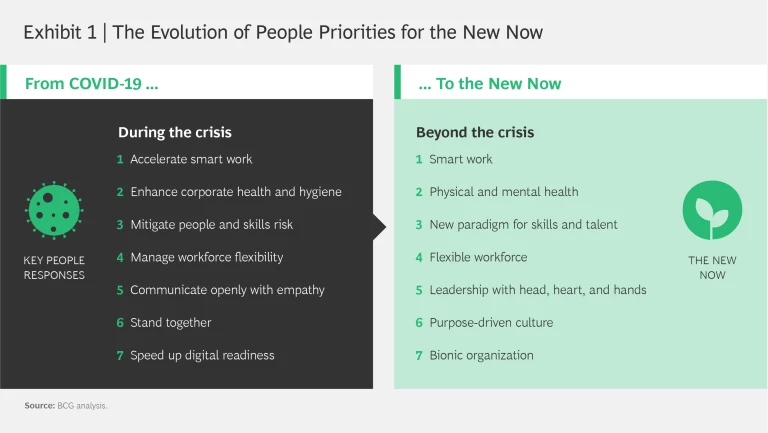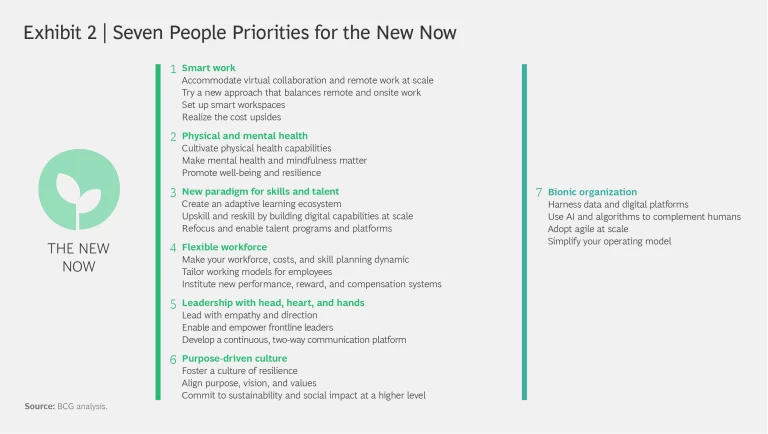Exponential growth in the coronavirus has led to exponential change across multiple dimensions of how we work. For many of us, our spaces for work and living have become one and the same. Those without the option of working remotely have had to take drastic precautionary measures for safety and social distancing. In reflecting on what has transpired, it’s clear that we are not going to return to where we left off before the outbreak.
The pandemic has given rise to three phases. The first is the crisis phase, which involves companies weathering the immediate impact. Then comes the ramp-up phase, defined by people starting to return to work. When and where each phase takes place depends on multiple factors, and as the world battles through them, a third is quickly coming into sight. In some ways, it has already taken hold. There’s been a lot of discussion about the “new normal” and “the future of work,” but these notions fail to capture the speed of change influencing our present reality. Organizations must look beyond the new normal, and instead anticipate and prepare for the “new now.”
The seven people priorities of the crisis response have paved the way for the seven people priorities of the new now. (See Exhibit 1.)
- During the crisis, we see an accelerated adoption of smart work (such as remote work, travel reduction, and virtual meetings). In the new now, smart work will be the standard across organizations.
- During the crisis, most companies implement effective measures to bring health and hygiene to the next level. In the new now, employees’ physical and mental health will be organizational cornerstones.
- During the crisis, organizations do a lot to mitigate people risks. In the new now, a new paradigm for skills and talent will emerge.
- During the crisis, we try to manage workforce flexibility. In the new now, we will have a flexible workforce.
- During the crisis, we communicate openly with empathy. In the new now, leadership will come from the head, heart, and hands.
- During the crisis, organizations endeavor to stand together with employees and society. In the new now, this momentum will lead to purpose-driven culture.
- During the crisis, companies drive their digital readiness. In the new now, the bionic organization will emerge with a new operating model and robust digital backbone.
The global crisis isn’t responsible for all of the recent changes in how we work and set up our organizations—see 12 Forces That Will Radically Change How Organizations Work —but it has sped up and shaped things greatly. As we look toward the future, seven people priorities will define the new now. (See Exhibit 2.) Companies need to accelerate their competitive advantage, and these people priorities have a critical role to play on the journey.
1. A Standard of Smart Work
Years’ worth of change has been accelerated in a matter of weeks, and the results are here to stay. Smart work has already arrived at many companies, but it will soon be the new standard across organizations.
Accommodate virtual collaboration and remote work at scale. In the new now, these practices must be efficient and sustainable. We will have to identify best practices (such as how to remain agile in remote settings ), establish new forms of leadership presence, and create virtual social intimacy to maximize workforce productivity. The focus will shift from activities to output, meaning “face time” and co-location will factor less into performance assessments. Remote work will not replace onsite work entirely, however, but instead complement it. Previous attempts at widespread remote work have not always been successful and in some cases have had to be reconsidered.
Try a new approach that balances remote and onsite work. The balance could take many forms, such as work-from-home days, a 50% model, or by shift switching between A and B teams. What’s essential in establishing new flexible paradigms for work is to set norms at the organizational level so that they can truly take hold—and to resist muscle memory recalling old habits. Digitalization of traditional paper processes will have to be accelerated as well.
Set up smart workspaces. Smart workspaces must be set up in all physical spaces—including offices, home offices, and production facilities—with technology that supports collaboration and teaming. In factories, smart manufacturing technologies can free workers from the most manual, inflexible tasks, and with continued high standards for hygiene and safety, will prevent future infections.
Realize the cost upsides. The advent of normalized smart work means saving money that would previously be spent on real estate and travel. New travel policies will be implemented to improve productivity, and these savings can be reinvested to fund the journey of adopting a new way of work across the organization.
2. Physical and Mental Health as Organizational Cornerstones
In the new now, physical health will be paramount, but so too will be mental health and other employee wellness initiatives that foster a resilient workforce.
Cultivate physical health capabilities. Ensuring employees’ physical health means being prepared for a rebound of the coronavirus, or for other potential infections. Standards for corporate hygiene will have to be kept high in the future. To catch returning threats early and to improve employee health at large, companies should leverage big data and digital tools—such as apps that promote social distancing, track the infection, or support the management of other health problems.
Going forward, employee health care must extend beyond physical concerns.
Make mental health and mindfulness matter. The crisis has caused an enormous amount of stress and difficult emotions for many employees that could linger even once it is over. A significant number of firms may emerge after the crisis with severe hits to their workforce and leadership, as well as to their bottom line, resulting in an implicit pressure felt by employees to make up for what has been lost. Coping with different stressors and managing cognitive overload during the crisis has taught us that going forward, employee health care must extend beyond physical concerns.
Promote well-being and resilience. These elements must be taken to the next level. Stable physical and mental health are necessary for us to develop ourselves further, and once these needs are met, we can learn, adopt new behaviors, and become progressively resilient and creative. Techniques that proactively enable better work-life balance—making work and private time more predictable through feedback, nudging, and the use of technology, for example—are key to maintaining a productive workforce.
3. A New Paradigm for Skills and Talent
To withstand the fast-paced and difficult times ahead, organizations will have to build new capabilities at unprecedented scale and speed.
Create an adaptive learning ecosystem. The crisis has taught us a lesson here. Those organizations that are best able to integrate reflection, learning, and innovation into their daily workflow are responding more readily to unforeseeable challenges. The crisis forced a massive technological push on corporations that will have a big impact on their learning ecosystems. Leaders and teams need to make the pursuit of new experiences, skills, and knowledge part of their daily routines. Holding frequent retrospectives, featuring a learning component in every meeting, peer coaching, and regular rotations across roles, functions, and even external positions must become the norm. Now more than ever, Competing on the Rate of Learning and how fast their organizations and employees can absorb change and build capabilities. This will continue to be true in the future.
Upskill and reskill by building digital capabilities at scale. Studies conducted before the pandemic had already predicted that over 60% of employees will need upskilling or reskilling in the coming years. The crisis has acted as a digital catapult, so “coming years” means “now.” Digital learning must take place at all levels. Senior leaders need a digital vision to lead the organization. Senior managers need digital fundamentals to build a digitalization agenda to get on the same page as their customers. These fundamentals will further help senior managers drive efficiencies and automation in operations in addition to helping them innovate new digital products.
Digitally savvy talent—who can employ new digital tools in their routines—are needed to deliver offerings and to become a part of the bionic company. Firms can use big data to develop customized matrices of digital skills to design and tailor integrated upskilling journeys with the right blend of live online sessions, on-the-job practice and coaching, as well as micro-nudges and learning boosts for individual employees.
Refocus and enable talent programs and platforms. This will help you recruit critical roles and retain valuable talent. Large companies will need to move quickly—even today—to take advantage of an increased talent pool that will be available from smaller, less resilient technology firms. Struggling startups are additionally great opportunities for “acquihiring,” or acquiring teams of talent by acquiring the firm they work for. Companies will rethink their overall approach on which talent and skills to build, buy, or borrow.
Novel ways of bringing in and developing capabilities at scale, such as the Build-Operate-Transfer (BOT) model , will become more widely used. In BOT programs, internal digital skills are built as new talent works side by side with experts who coach and facilitate while delivering digital priorities. This model of building skills reduces reliance on outsourcing critical digitally based competitive advantage.
4. A Flexible Workforce
In an increasingly volatile environment, managing workforce capacities will be of the utmost importance. Alternative employment models are already pushing the boundary of the traditional nine-to-five job. Organizations will have to keep up in the new now.
Make your workforce, costs, and skill planning dynamic. Fluctuations in the supply and demand of skills and talent that results from changing business needs will be flexibly simulated much more proactively and frequently. New AI-based technologies make it possible to assess workforce scenarios down to the individual skill level and can inform such focused HR action steps as the greater use of contractors, gig workers, flexible hours, or addressing upskilling requirements.
The crisis ushered in a shift in talent from areas of over-capacity to areas of scarcity (from retail outlets to distribution, for example). With this shift came a broadening of skill sets. Plentiful and purposeful cross-staffing will not only ensure flexibility throughout the next waves of this and future crises, but also broaden the perspectives and skills of employees in general.
Tailor working models for employees. Companies and employees will need to tailor working models along three dimensions to keep up with the growing demand for flexibility: Space, or how much work is done on site and how much is done remotely; Time, or the existence of reduced and flexible-timing arrangements; Forms of affiliation, or whether an employee is contracted, contingent, a freelancer, or other.
Companies should also rethink their workforce strategies based on important questions. Which value-driving skills should be incubated internally? What positions should be open for part-time employment? How much flexibility should be granted to remote and offsite workers? Organizations may even consider setting up an in-house “gig squad”—a team of highly skilled individuals retained for a minimum number of monthly hours—that works with full flexibility in exchange for granting the employer reliable access to internal expertise.
Institute new performance, reward, and compensation systems. They will be needed to help integrate new KPIs and success metrics based on flexible working models. The crisis has taught us the drawbacks of our current, inflexible remuneration systems—some companies that were pressured to adjust means of compensation may have found their hands tied. The pressure for increased flexibility will only grow as firms rebuild their workforce, especially as new and flexible working models require increasingly nuanced considerations.
How quickly can we move to a more team-oriented system that reinforces the enhanced cooperation and collaboration brought by the crisis? How should compensation be distributed among new skill sets and working models? How much should be paid as a fixed base instead of as a bonus or other benefit? What is our compelling total offer beyond cash compensation? Which performance metrics should determine compensation, and will my current HR processes be able to support the new system? The answer to these questions will have a drastic impact on your organization’s attractiveness as a flexible employer.
5. Leadership with Head, Heart, and Hands
Empathy and adaptiveness must be at the core of future leaders’ capabilities, requiring three elements:
- The head is required for envisioning the future and the focused priorities required to succeed.
- The heart is needed to inspire and empower employees.
- The hands are needed to ensure innovative and agile-execution capabilities.
Lead with empathy and direction. Connecting with employees will take authentic, humanity-driven leadership. CEOs from some of the hotel and airline companies hit hardest by the crisis have shared authentic and heartfelt announcements with their employees, providing full transparency into the difficulties their organizations face in taking crisis management measures.
Before the coronavirus, the heart was one of the most ignored elements of leadership . A new model of leading with the heart has emerged from the many stories of leaders stopping by production facilities or reaching out to employees to congratulate them on a job well done (or to offer their support), be it physically or virtually.
Organizations will need to dramatically increase the support they provide frontline leaders.
Enable and empower frontline leaders. As companies race to meet their digital future in the new now, employees will need to integrate technology into their day-to-day more than ever before—working across digital and non-digital channels, and with a larger percentage of processes automated to reduce costs and health risks for those who carried them out manually. Once smart work and flexible forms of affiliation have fully become the standard, managers will have to be ready to lead their teams effectively. Managing agile teams is fast becoming a core leadership task that entails a fundamentally new approach to giving directions, providing autonomy, and focusing on outcomes instead of activities. Organizations will need to dramatically increase the support they provide these frontline leaders to manage teams working with new technologies, both in new, flexible virtual models and in agile ways of working.
Develop a continuous, two-way communication platform. Leaders will need help understanding and listening to their employees’ needs. Weekly pulse check tools, digital focus groups, crowdsourcing, and feedback culture will help leaders gather data and inform their decisions while also ensuring employees feel heard. The need for empathy has been accelerated by the recent hardship and will soon become a hallmark of leading companies.
6. Purpose-Driven Culture
In the new now, companies will embrace deep-seated values and ensure their organizations are driven by purpose.
Foster a culture of resilience. It will be essential for senior management to ensure that employees and leaders reflect on learnings from the crisis—based upon their experiments with new technology, working across silos, and developing new routines—to continue moving work forward. The crisis has created admirable examples of this kind of culture across countries and industries, and successful companies will build on the existing momentum.
Align purpose , vision, and values. Following the crisis, organizations will be able to re-evaluate these elements and recommit themselves to meeting people’s heightened expectations of business’s role in society. For example, Dumpling Xi, a restaurant chain in China, showed its commitment to altruism during the crisis by sharing learnings from the previous SARS outbreak with the entire catering community.
Commit to sustainability and social impact at a higher level. Incorporate learnings from the crisis to better engage your workforce, customers, and society. Leverage the acceleration of trends (such as smart work) to meet long-standing sustainability and social impact targets. Less travel and greater virtual collaboration will mean fewer CO2 emissions. By the same token, companies can look to increasingly flexible forms of employment to build diversity within their organizations.
7. The Bionic Organization
The crisis has catapulted the world five to ten years into its digital future and created the opportunity for businesses to accelerate the revolution and simplification of their operating models.
The crisis has catapulted the world five to ten years into its digital future.
Harness data and digital platforms. Human and technological capabilities will reinforce each other in a more flexible, adaptive, data-driven, and digital organization. The organization of the future will offer personalized and continuously improved customer and employer journeys that spur growth, innovation, efficiency, and resilience.
In this environment, companies must become bionic by adopting a backbone of next-level, multidimensional digitalization. Achieving this will depend on how technological applications become the basis of core value-creating processes, on how the use of data and analytics will transform decisions across business and support functions, and from the dramatic shift in employee skill sets—in how employees respond to the digital shift while enabling it to happen.
Use AI and algorithms to complement humans. Advanced technology can take over repetitive tasks from humans, enable better decision making, and even be used for co-creation. In the years ahead, automation will not only streamline processes that are less essential and were once manual (allowing people to focus on critical elements), but also keep employees safer in a more safety-conscious world.
Adopt agile at scale. Like technology, organizational forms will adapt rapidly to the context of the new now. Corporate survival will depend on managing a larger ecosystem of evolving roles and tasks. People processes will change, lending greater flexibility to the employer value proposition, career paths, recognition, personal development, and performance management. The skills and people qualities that thrive in this dynamic context will be promoted. The key task of leadership will also be different. Leaders will have to manage a process of constant re-calibration—of their objectives, activities, and structures.
Simplify your operating model. The crisis has forced many to rethink their organizations. Use the opportunity to review your operating model, streamline the organization, reduce duplications and layers, digitize and simplify processes, decrease administration and non-value-added tasks, and to redeploy teams to core activities.
Build on the Acceleration Ignited by the Crisis
Crises are like forest fires—amid the tragedy emerge the seeds of renewal and growth. The response of many organizations to the pandemic has already shown this to be the case. We’ve seen a rapid proliferation in smart work, the birth of previously unseen flexible workforce solutions, the rapid upskilling and reskilling of employees , and of course, many admirable examples of leadership, worldwide.
The new now is on the horizon. Companies must rise to the challenge of overcoming adversity to build on the current momentum and look toward these examples as promising signs of the larger change opportunity ahead. The crisis is forcing us to question and rethink our basic operating models and to coalesce small steps into an orchestrated leap forward. For companies to win in the medium term, they will have to fundamentally redesign their organizations and ways of working. As always, those that act fastest will benefit most.
















